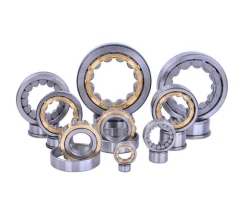Types of linear bearings
2023-12-11
Linear bearings are designed to provide motion in a straight line, allowing for linear or translational movement rather than rotational. These bearings play a crucial role in various applications where smooth and precise linear motion is required. Here are some common types of linear bearings:
1. Linear Ball Bearings:
- Consist of balls that circulate within a closed system, typically in a carriage or slide unit.
- Suitable for applications requiring low friction and high precision.
2. Linear Roller Bearings:
- Use cylindrical rollers instead of balls to provide linear motion.
- Can handle higher loads compared to linear ball bearings.
3. Linear Sleeve Bearings:
- Similar to traditional sleeve bearings, these linear bearings consist of a sliding mechanism to provide linear motion.
- Generally used in applications with lighter loads and lower precision requirements.
4. Linear Bushings:
- Utilize a bushing or sleeve to guide a shaft linearly within a housing.
- Suitable for applications where precision and low friction are essential.
5. Linear Guideways:
- Consist of a linear rail and a carriage that travels along the rail.
- Ideal for high-precision applications, such as CNC machines.
6. Profiled Rail Bearings:
- Similar to linear guideways but typically used in heavier-duty applications.
- Provide high load capacity and rigidity.
7. Ball Screw Assemblies:
- Combine a ball screw and a nut with ball bearings to convert rotary motion into linear motion efficiently.
- Used in applications requiring high precision and efficiency, such as CNC machines.
8. Lead Screw Assemblies:
- Similar to ball screw assemblies but use sliding friction rather than rolling elements.
- Suitable for applications with lower precision requirements.
9. Crossed Roller Bearings:
- Feature crossed cylindrical rollers arranged in a V shape between two guides.
- Offer high load capacity and stiffness for precise linear motion.
10. Linear Motion Systems:
- Complete systems that include linear bearings, rails, and often a drive mechanism (such as a belt or lead screw).
- Used in various automated and robotic systems.
11. Air Bearings:
- Utilize a thin film of pressurized air to lift and support the load, providing ultra-smooth and frictionless linear motion.
- Commonly used in precision manufacturing and measurement equipment.
12. Magnetic Bearings:
- Use magnetic fields to levitate and guide the moving parts without physical contact.
- Suitable for high-precision applications.
The choice of linear bearing depends on factors such as load capacity, precision requirements, speed, and environmental conditions. Linear bearings find application in a wide range of industries, including manufacturing, automation, robotics, aerospace, and medical devices, where precise and smooth linear motion is essential.



